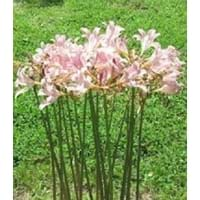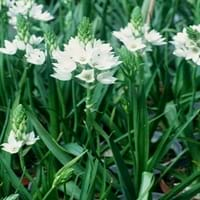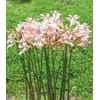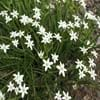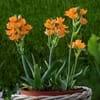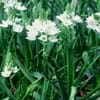Life Span
Perennial
Perennial
Type
Bulb or Corm or Tuber
Bulb or Corm or Tuber
Origin
Not Available
Southern Africa, South Africa
Types
Not Available
not available
Habitat
Subtropical climates, Sunny Edge
marshes, Sandy flats, Slopes
USDA Hardiness Zone
Not Available
7-10
AHS Heat Zone
Not Available
10-7
Habit
Clump-Forming
Clump-Forming
Minimum Height
Not Available
Minimum Width
Not Available
Flower Color
White, Orange, Pink, Hot Pink, Coral, Crimson, Lavender, Ivory
Orange, Gold
Flower Color Modifier
Bicolor
Bicolor
Fruit Color
Not Available
Not Available
Leaf Color in Spring
Green, Gray Green, Dark Green
Green, Blue Green, Yellow green
Leaf Color in Summer
Light Green
Light Green
Leaf Color in Fall
Several shades of Green
Several shades of Green
Leaf Color in Winter
Light Green
Light Green
Leaf Shape
Long linear and narrow
Succulent
Plant Season
Spring, Summer, Fall
Spring, Winter
Sunlight
Full Sun, Partial Sun
Full Sun, Partial Sun, Partial shade
Growth Rate
Medium
Not Available
Type of Soil
Not Available
Clay, Loam, Sand
The pH of Soil
Not Available
Acidic, Neutral, Alkaline
Soil Drainage
Well drained
Well drained
Bloom Time
Late Summer, Early Fall, Fall
Early Spring, Spring, Winter, Late Winter
Tolerances
Drought
Drought
Where to Plant?
Ground
Container, Ground
How to Plant?
From bulbs
Bulbs, Seedlings
Plant Maintenance
Medium
Medium
Watering Requirements
Needs very little water
Keep ground moist, Reduce watering in winter, Water three times weekly in summer
In Summer
Lots of watering
Lots of watering
In Spring
Moderate
Moderate
In Winter
Average Water
Average Water
Soil pH
Not Available
Acidic, Neutral, Alkaline
Soil Type
Not Available
Clay, Loam, Sand
Soil Drainage Capacity
Well drained
Well drained
Sun Exposure
Full Sun, Partial Sun
Full Sun, Partial Sun, Partial shade
Pruning
Cut back the foliage when the plants die back naturally, Remove damaged leaves, Remove dead branches, Remove dead leaves
Prune to control growth, prune to control shape, Prune to stimulate growth
Fertilizers
All-Purpose Liquid Fertilizer
All-Purpose Liquid Fertilizer
Pests and Diseases
Pests and diseases free
Not Available
Plant Tolerance
Full Sun
Drought
Flower Petal Number
Single
Single
Foliage Texture
Medium
Medium
Foliage Sheen
Matte
Glossy
Attracts
Bees, Butterflies, pollinators
Butterflies, Insects, pollinators
Allergy
Unknown
Skin irritation, Skin rash, Toxic
Aesthetic Uses
Beautification, Cottage Garden, Informal Hedge, Mixed Border, Showy Purposes
Beautification, Cut Flowers, Showy Purposes, Used as an interior landscaping species, Used for decorating walls, fences, gates, hedges, etc.
Beauty Benefits
Not Available
Not Available
Environmental Uses
Air purification, Deer resistant, Food for insects
Air purification
Medicinal Uses
Unknown
Not Available
Part of Plant Used
Bulbs
Flowers
Other Uses
bulb used as starch
Beneficial species for attracting pollinators, Showy Purposes, Used as Ornamental plant, Used for Landscaping
Used As Indoor Plant
No
Yes
Used As Outdoor Plant
Yes
Yes
Garden Design
Cutflower, Feature Plant, Mixed Border
Container, Cutflower, Mixed Border, Rock Garden / Wall
Botanical Name
LYCORIS
Ornithogalum thyrsoides
Common Name
Naked Ladies, Spiderlily, Surprise Lily
Chincherinchee, Wonder-flower, Star-of-Bethlehem
In Hindi
surprise lily
Chincherinchee
In German
Überraschung Lilie
Kap-Milchstern
In French
Lycoris squamigera
Chincherinchee
In Spanish
Lycoris squamigera
Chincherinchee
In Greek
surprise lily
Ornithogalum thyrsoides
In Portuguese
surpresa lírio
Chinkerinchee
In Polish
niespodzianka lilia
Chincherinchee,
In Latin
surprise lily
Chincherinchee
Phylum
Not Available
Magnoliophyta
Class
Liliopsida
Liliopsida
Order
Asparagales
Asparagales
Family
Amaryllidaceae
Asparagaceae
Genus
Lycoris
Ornithogalum
Clade
Angiosperms, Monocotyledonous
Angiosperms, Monocots
Tribe
Not Available
Ornithogaleae
Subfamily
Amaryllidoideae
Scilloideae
Number of Species
Not Available
Season and Care of Surprise Lily and Chincherinchee
Season and care of Surprise Lily and Chincherinchee is important to know. While considering everything about Surprise Lily and Chincherinchee Care, growing season is an essential factor. Surprise Lily season is Spring, Summer and Fall and Chincherinchee season is Spring, Summer and Fall. The type of soil for Surprise Lily is Not Available and for Chincherinchee is Clay, Loam, Sand while the PH of soil for Surprise Lily is Not Available and for Chincherinchee is Acidic, Neutral, Alkaline.
Surprise Lily and Chincherinchee Physical Information
Surprise Lily and Chincherinchee physical information is very important for comparison. Surprise Lily height is Not Available and width Not Available whereas Chincherinchee height is 20.30 cm and width 15.20 cm. The color specification of Surprise Lily and Chincherinchee are as follows:
Surprise Lily flower color: White, Orange, Pink, Hot Pink, Coral, Crimson, Lavender and Ivory
Surprise Lily leaf color: Green, Gray Green and Dark Green
Chincherinchee flower color: Orange and Gold
- Chincherinchee leaf color: Green, Blue Green and Yellow green
Care of Surprise Lily and Chincherinchee
Care of Surprise Lily and Chincherinchee include pruning, fertilizers, watering etc. Surprise Lily pruning is done Cut back the foliage when the plants die back naturally, Remove damaged leaves, Remove dead branches and Remove dead leaves and Chincherinchee pruning is done Prune to control growth, prune to control shape and Prune to stimulate growth. In summer Surprise Lily needs Lots of watering and in winter, it needs Average Water. Whereas, in summer Chincherinchee needs Lots of watering and in winter, it needs Average Water.
